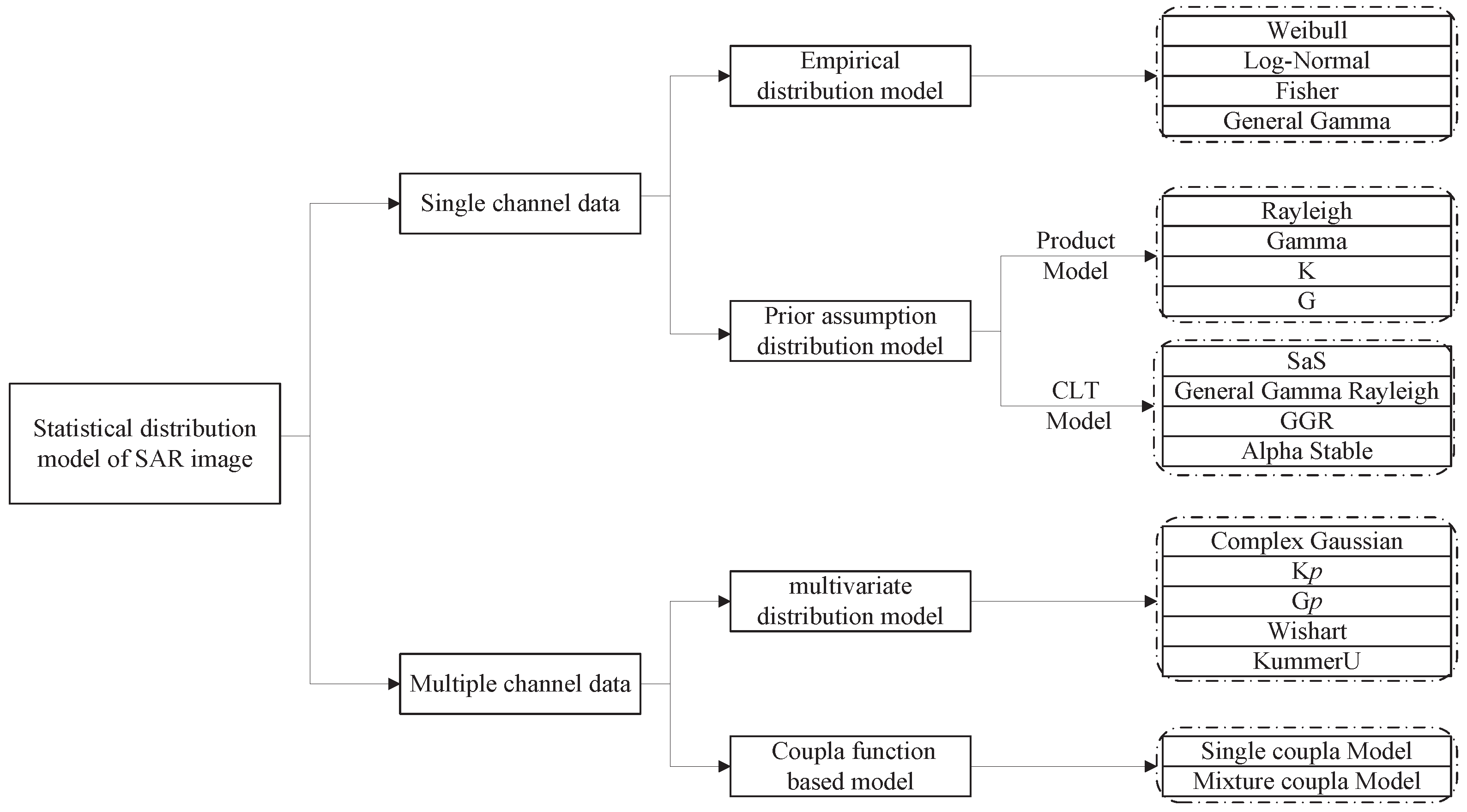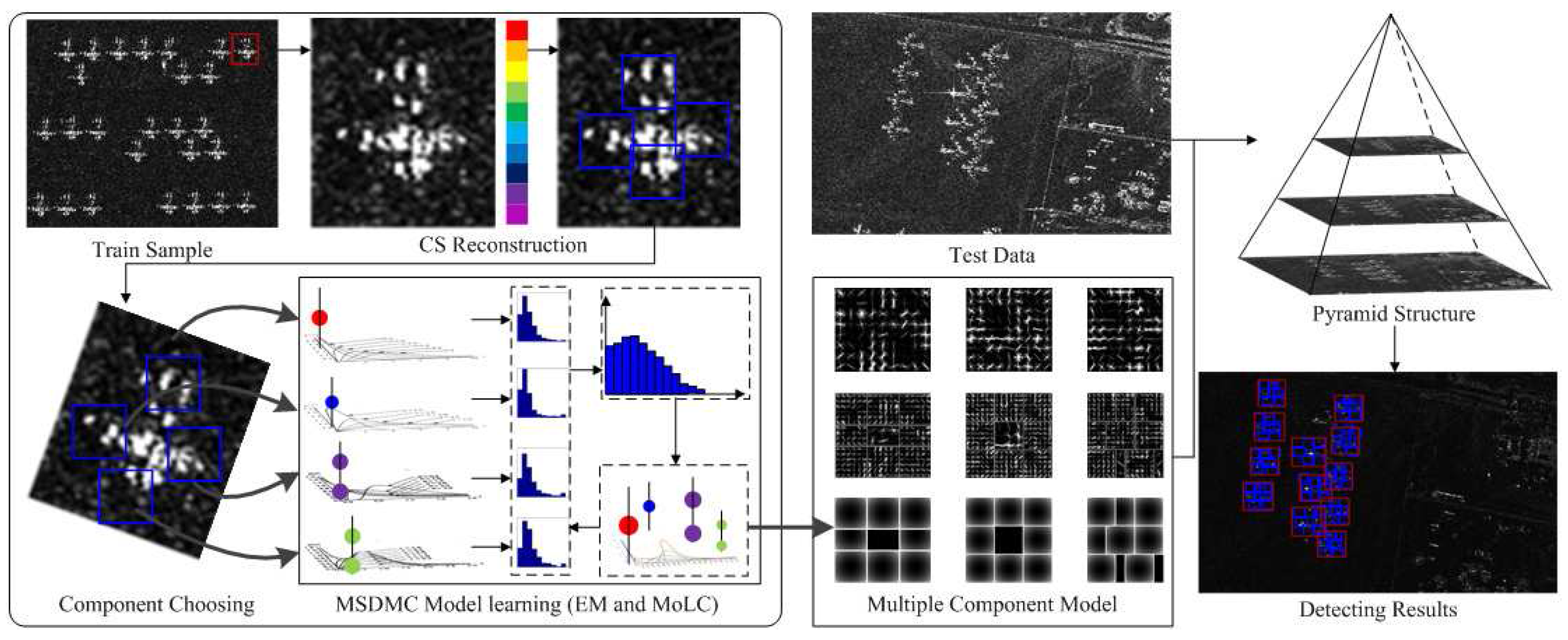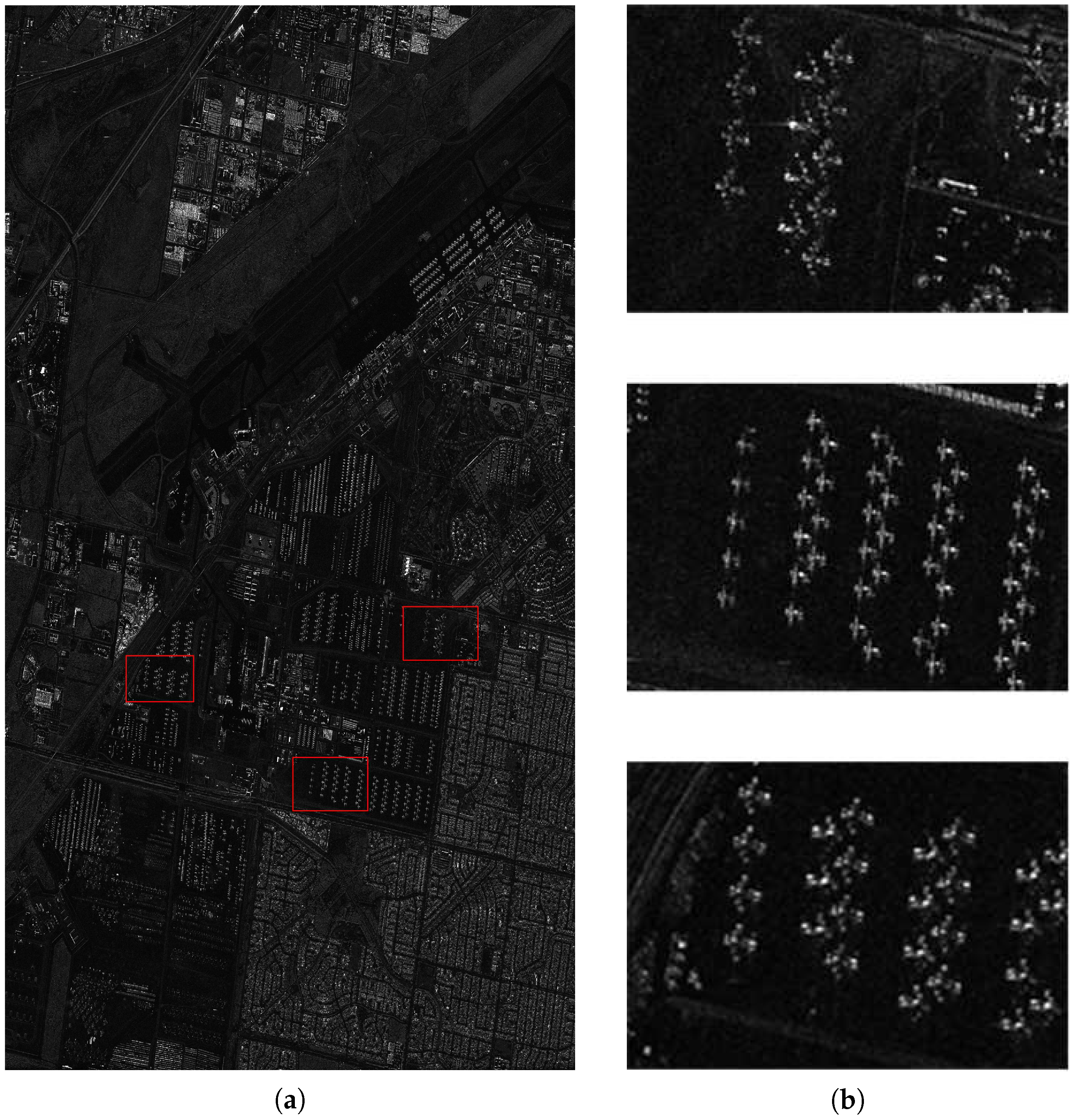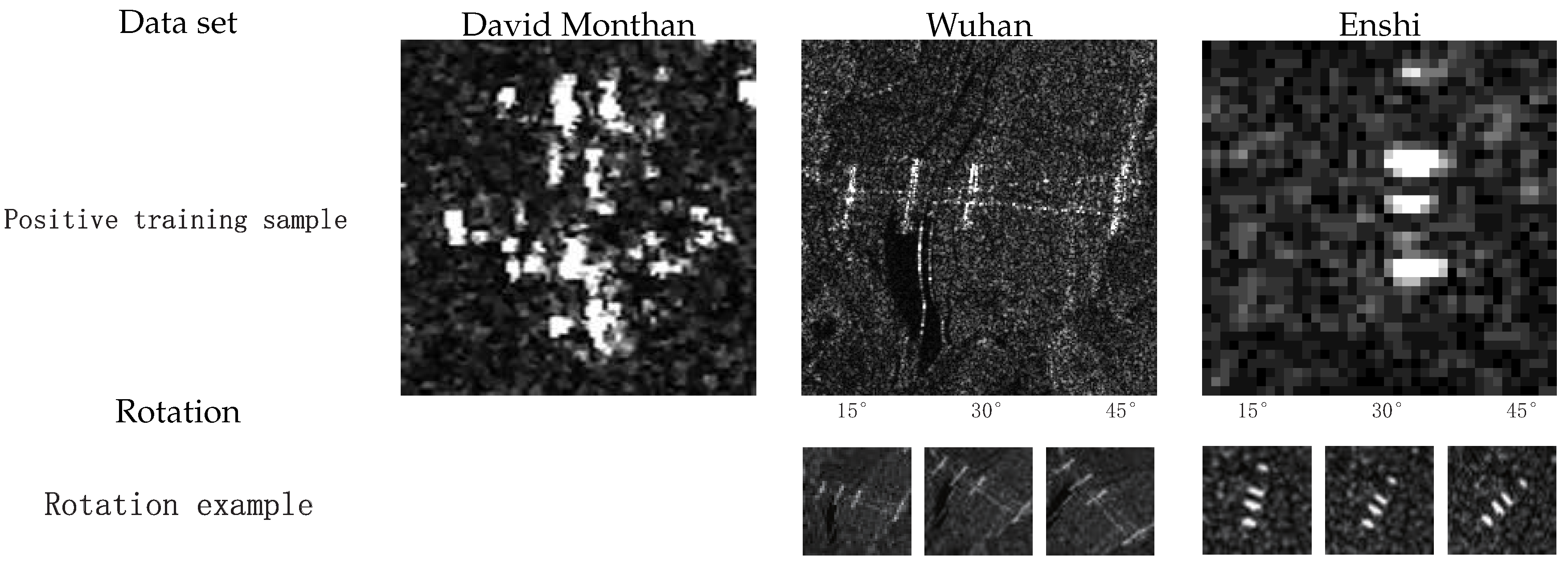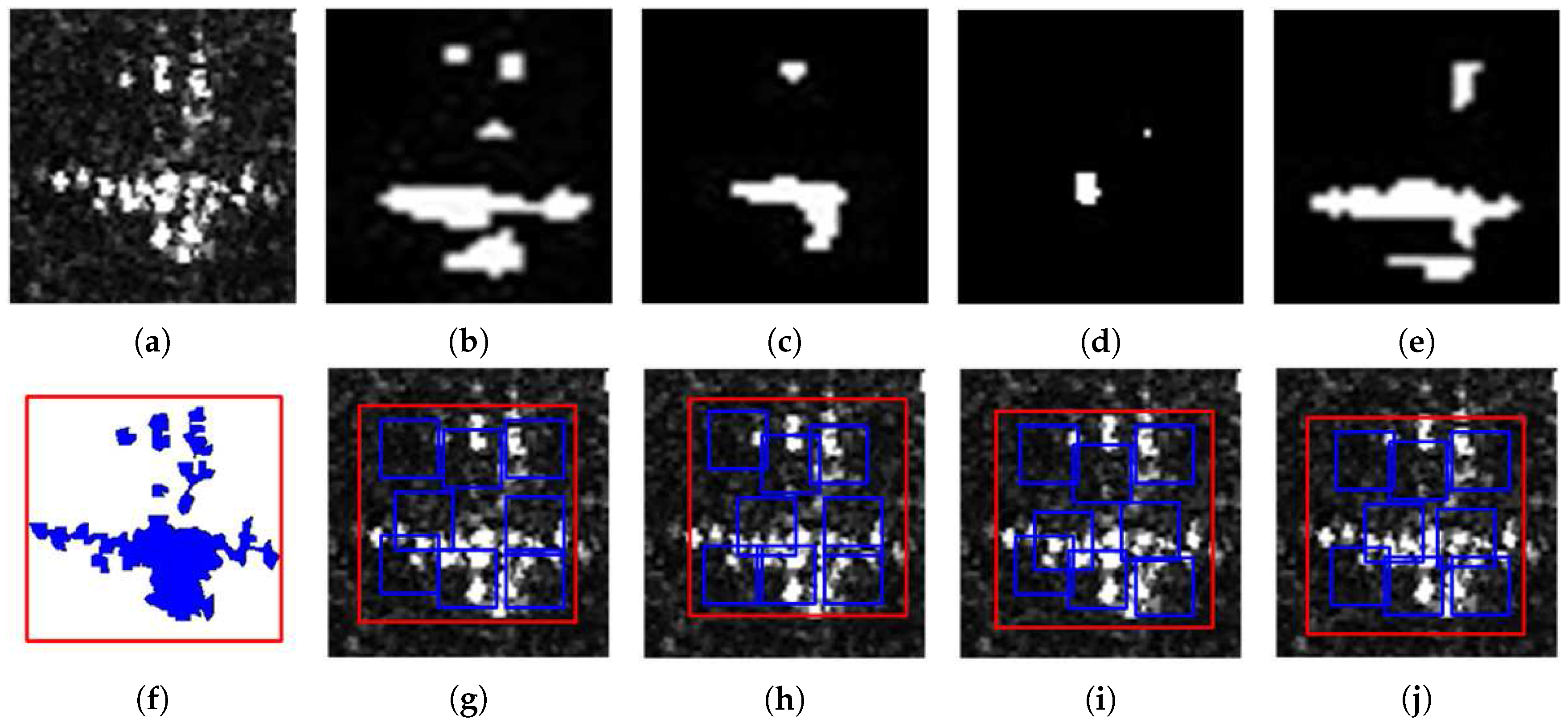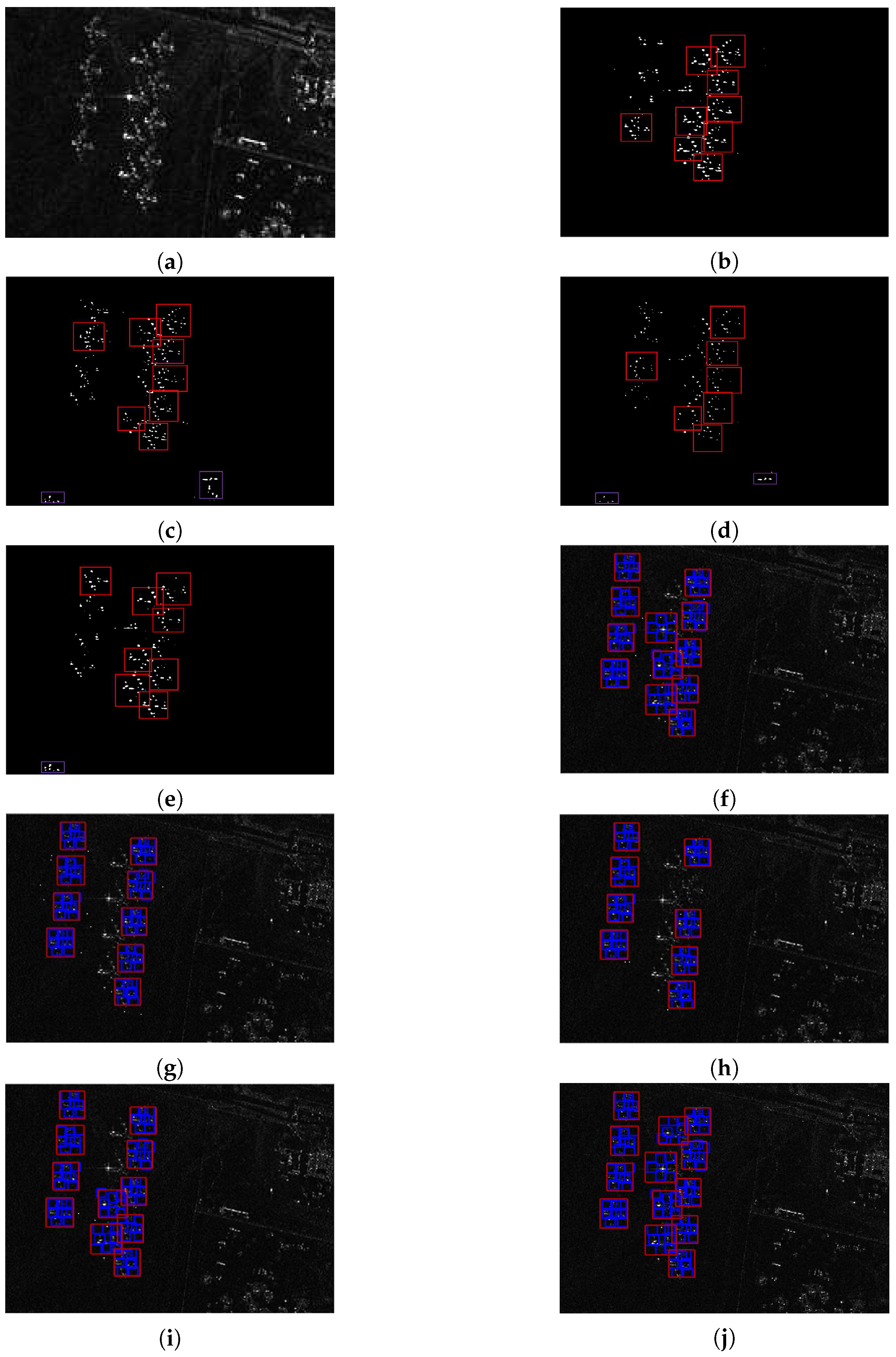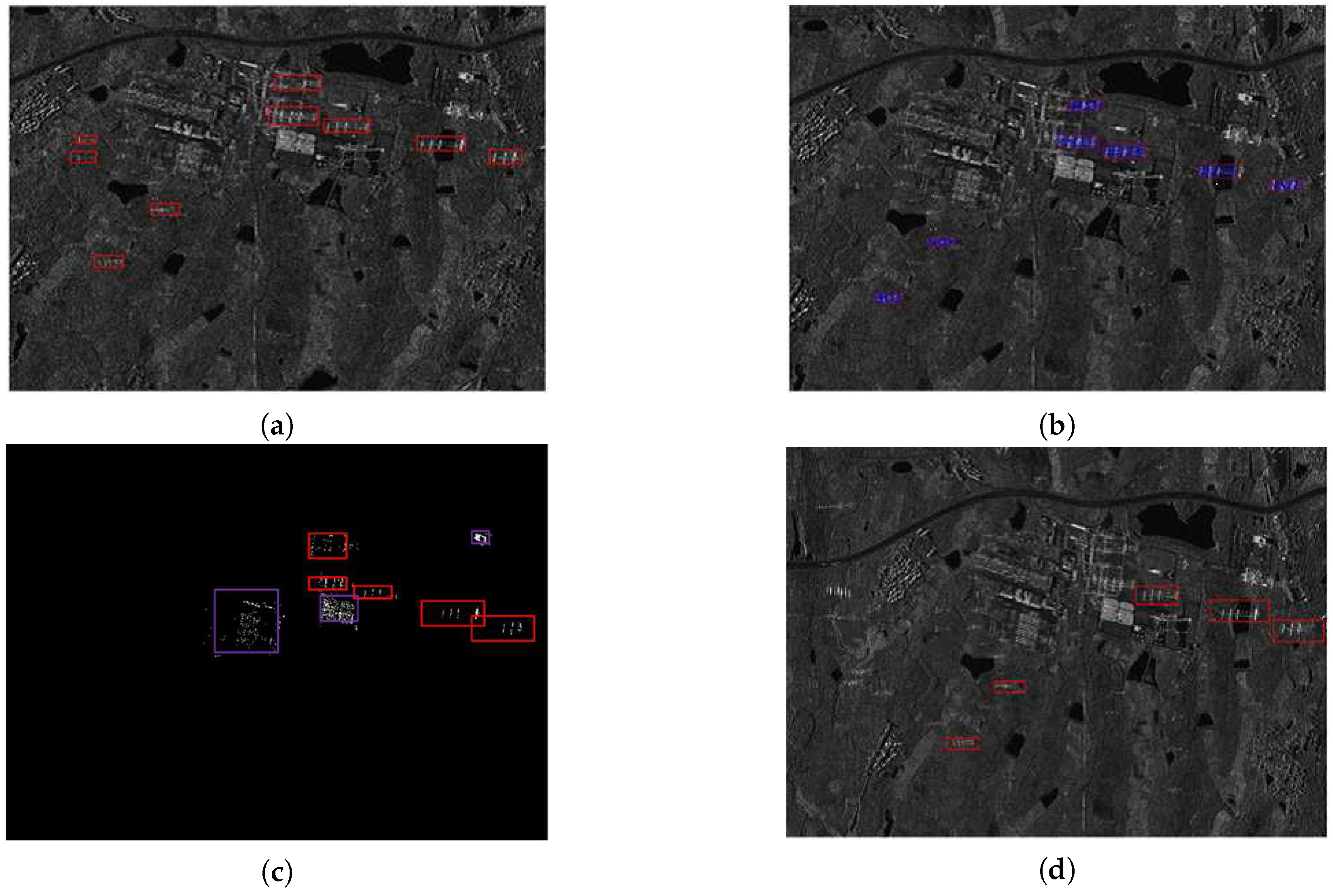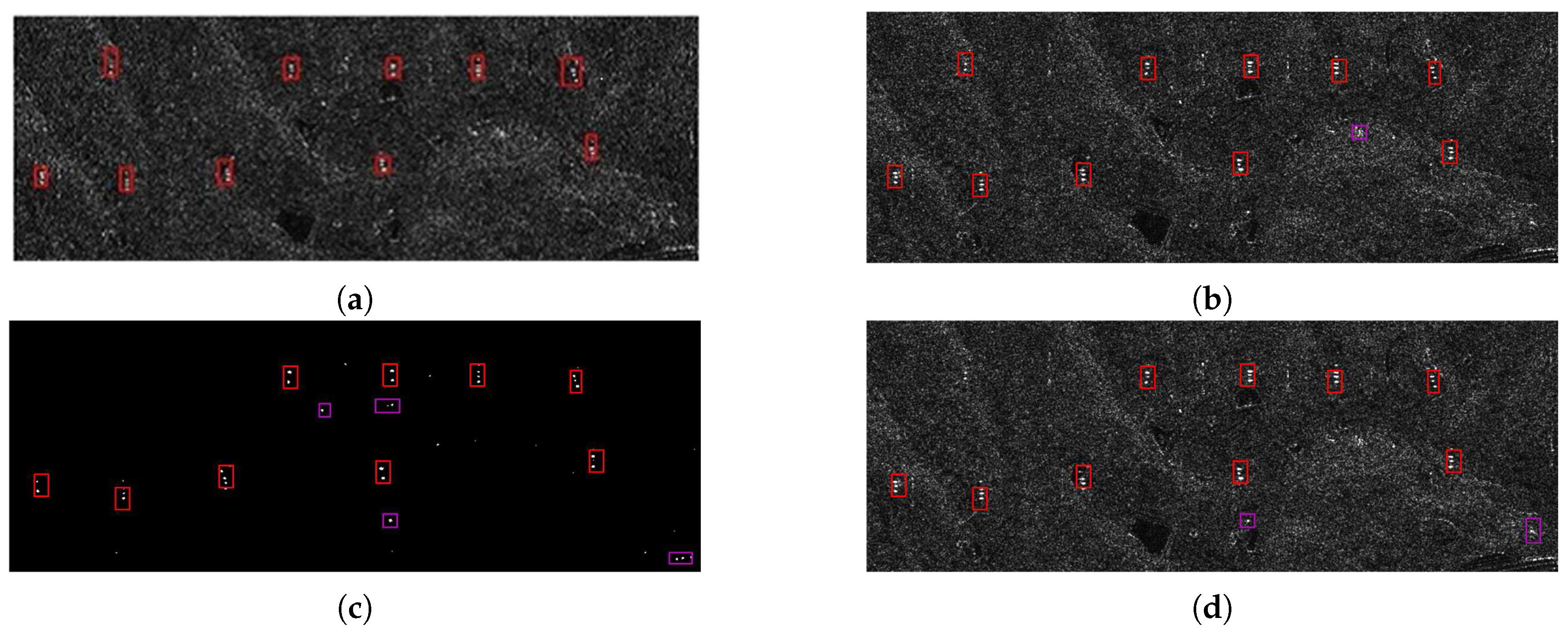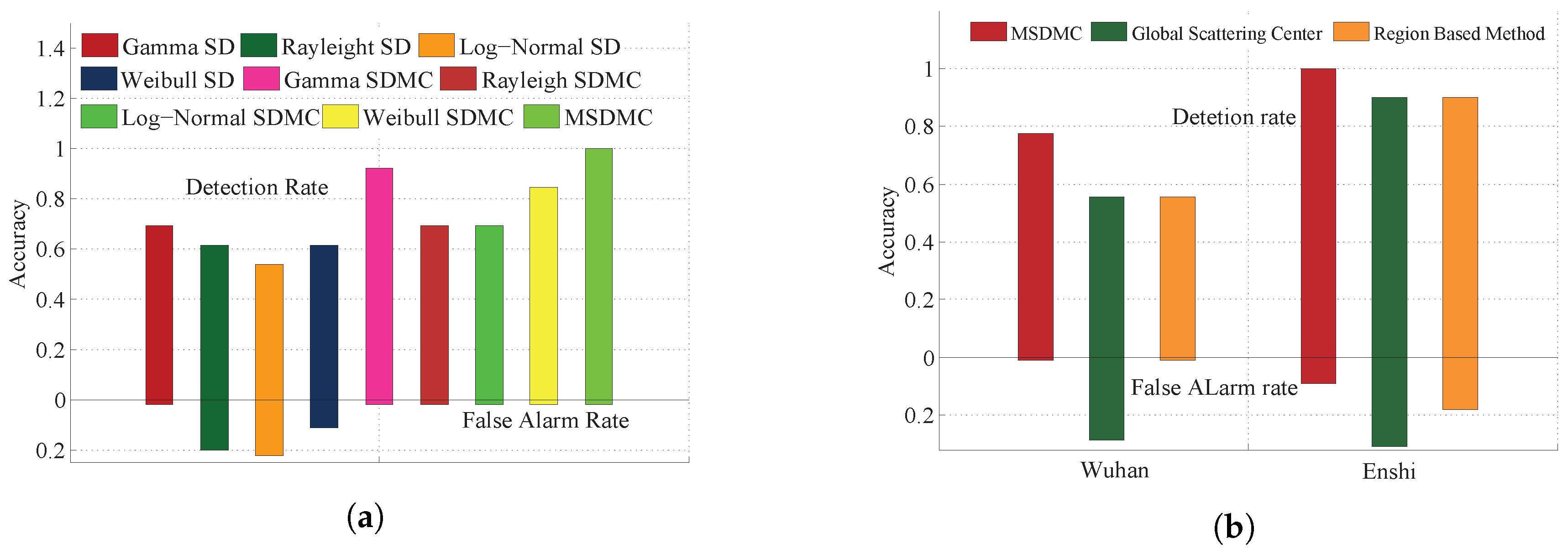1. Introduction
Target detection in Synthetic Aperture Radar (SAR) imagery is an important application in remote sensing research. With the increasing availability of spaceborne SAR images, effective techniques for object detection have become desirable. Numerous algorithms have been developed in response to the need for target detection in SAR imagery with different spatial resolutions.
In low spatial resolution SAR imagery, Constant False Alarm Rate (CFAR) [
1,
2], in which an adaptive threshold is adopted, has become the most widely used method. In [
3], the statistical distribution of the background clutter is assumed to be Gaussian to obtain the adaptive threshold. Based on the contrast between the target and the background, the Generalized Likelihood Ratio (GLR) [
4] method has also been proposed based on the clutter’s statistical distribution features to achieve an optimal solution under a Bayesian framework. In medium spatial resolution SAR imagery, linear targets, such as oceans and oil spills, can be detected using a Radon transform method [
5,
6]. To enhance the discrimination between the target and the background, Kaplan [
7] proposed the Extended Fractal (EF) feature, which introduced the Hurst index to measure texture roughness at different scales. By contrast, Tello [
8] utilized the different characteristics of a target in the spatial and frequency domains to improve the detection results. Wang [
9] employed the sub-aperture correlation method for object detection in polarimetric SAR data. Moreover, the coherent spatial filtering scheme [
10] takes advantages of a linear function that has demonstrated its validity in improving the ratio between the target and the clutter. Nevertheless, with the improvement of SAR systems, the object of interest is no longer limited to within several pixels, and more complex and rich information is provided. Therefore, researchers begin to focus more on SAR imagery with high spatial resolution.
In high-resolution SAR imagery with a pixel spacing of several meters, appearance variations in the same targets suggest that traditional detection algorithms are not suitable. Thus, Tan et al. proposed an adaptive aircraft-detection method based on a gradient textural saliency map in which a target’s morphological details, such as its structure and shape, could be resolved [
11,
12]. Huang et al. presented a new ship-detection method based on multi-scale heterogeneities with few parameters to be determined [
13]. To draw on the advantages of the above methods, the rich information of a target, such as its texture, spatial relationship, shape and structure has been considered for better target-detection results in SAR imagery [
14,
15,
16]. In [
17], regional features were utilized to implement the global scattering center model-based region-to-point match scheme to improve the detection performance.
With respect to the different response of a target at different spatial resolutions, we design a multi-scale detector based on the part-based deformable model [
18,
19,
20] for object detection. The target in the traditional detection result is usually labeled with a bounding box, and no attention is given to each component. For example, an airplane is generally composed of a head, an airframe, two wings and a tail. However, traditional methods have not investigated the latent information between the airplanes and its corresponding parts, which means that each component may not be located in the region of interest. Therefore, a multiple-component scheme inspired by the part-based deformable model is studied to describe the spatial relationships among each component. In the multiple-component model, the whole target is located by the root filter at coarse spatial resolution and the components are oriented by the corresponding part filters at high spatial resolution. Moreover, aiming to obtain rich structural information, we utilize mixture statistical distributions [
21] to characterize each component, which is a useful method for object detection in high-resolution SAR images.
In this paper, the Mixture Statistical Distribution Based Multiple Component (MSDMC) model is constructed with the following procedures. In the preprocessing step, an Orthogonal Matching Pursuit (OMP) based Compressed Sensing (CS) [
22,
23] approach is responsible for suppressing the speckle noise, which helps to eliminate the heavy tails and the intra-class variance to reconstruct the SAR image. Then, a multiple-component model inspired by a part-based deformable model is introduced to describe structural relationships between the target and its components through a root filter and some part filters. The root filter derives the coarse-scale information of the target, and the part filters are applied to construct multiple components at fine spatial resolution. Furthermore, to model the statistical characteristics of the target, the mixture statistical distribution model is adopted and the Method of Logarithmic Cumulants (MoLC) based Expectation Maximization (EM) iteration approach is employed to estimate the parameters [
24,
25]. Finally, the mixture statistical distributions are incorporated into the multiple-component model to generate the MSDMC model through latent Support Vector Machine (SVM) learning procedures [
26,
27,
28,
29]. It is worth noting that the latent SVM approach utilizes training samples with labeled bounding boxes to generate the initial locations of the components through the gradient descent method. In the experiment, the data sets include two types of targets. In the airplane data set, the target-detection results of the statistical distribution-based CFAR method and the corresponding Single Distribution Based Multiple Component (SDMC) algorithms are compared to verify the effectiveness of the structure modeling. For the electrical power tower data set, the proposed method and contrastive methods, including the global scattering center model and the region-based method are tested, and the MSDMC model outperforms the other algorithms by achieving the highest detection rate and lowest false alarm rate.
This paper is organized as follows.
Section 2 describes the fundamental principle of the multiple-component model for object detection in high spatial resolution SAR imagery. The complete framework of the MSDMC model is presented in
Section 3. In
Section 4, representative experiments of the proposed MSDMC algorithm and some comparative methods are conducted using TerraSAR-X SAR images, and detailed results and analysis are provided.
Section 5 summarizes the final conclusion.
4. Experiment
4.1. Description of the Experiment
To evaluate the performance of the proposed MSDMC model, three high-resolution SAR data sets containing different targets are collected. The details of the experimental data sets are listed in
Table 2.
The data set used for airplane detection is the TerraSAR-X spotlight data set with the Horizontal-Horizontal(HH) channel, which contains approximately 4200 planes and is acquired over the Davis–Monthan AFB Force Base (AFB). This SAR data set has a pixel spacing of 2 m and image size of
pixels, from which we select a sub-region of
pixels to conduct the experiments in this paper. The overview and three sampling areas of the the Davis–Monthan AFB are shown in
Figure 3.
Two TerraSAR-X data sets with different spatial resolutions are used for electrical power tower detection. One is from the suburban area of Wuhan, Hubei Province, China, and the data set is acquired in spotlight mode and the VV channel with a pixel spacing of one meter. The image size is pixels. The other SAR image data is from the rural area of Enshi in the HH channel with a pixel spacing of 3 m, and an image size of pixels.
4.2. Experiments and Discussion
To evaluate the performance of the proposed algorithm, experiments are conducted with a Davis–Monthan data set on the statistical distribution-based CFAR methods, the corresponding Single Distribution Based Multiple Component (SDMC) models, and the mixture statistical distribution-based multiple-component model. Until now, CFAR detectors are commonly used for detecting the targets in SAR images. Moreover, the CFAR method can determine whether a pixel belongs to a target, and output the isolated discriminative results without considering the relationships with the neighboring pixels. In the experiment, four single statistical distribution-based CFAR methods are designed and compared with the corresponding SDMC models, in order to reflect the function of the multiple-component model. Another novelty of this method is adopting mixture statistical distributions, whose advantage over single distributions is reflected by the comparison between the four single statistical distribution-based SDMC methods and the overall MSDMC model.
For Wuhan and Enshi data sets, the effectiveness of the proposed MSDMC model is compared with the global scattering center model [
17] and the region-based model [
42] to detect the electrical power tower. The quantitative assessment of the target detection results by the different algorithms involves the following two precision indexes: (1) detection rate (the ratio of the number of correctly detected to the total number of targets); (2) false alarm rate (the ratio of false positive targets to the total number of the targets).
4.2.1. Selection of Training Samples and Testing Samples
For the Davis–Monthan data set, samples include 80 positive samples with single airplanes and 200 negative samples covering various roads, buildings, and cars. Furthermore, 30 positive samples and all the negative samples are used as training samples for the multiple-component model, and the remaining 50 positive samples are used as testing samples. The size of each sample is pixels.
For the Wuhan and Enshi data sets, the total numbers of samples are ten and nine, respectively, and five samples are selected from each as positive samples. However, the current positive samples are insufficient for model training. To enlarge the positive training samples, five positive samples are rotated by
in this experiment, as shown in
Figure 4 and
Table 3. This procedure ensures the adaptability of the multiple components by considering different target orientations in SAR scenes. Thus, 10 positive samples are obtained, and 50 negative samples containing roads, buildings and forests are selected as negative training samples. The remaining sampling areas are processed in the same way to construct the testing samples by rotating the original images by
,
and
. Thus, the number of the positive testing samples is 20 for the Wuhan data set and 16 for the Enshi data set. The size of the samples selected from the Wuhan data set is
pixels. It is worth noting that the samples selected from the Enshi data set have an image patch size of
pixels. An illustration of the training samples is presented in
Figure 4.
4.2.2. Airplane Detection Results
4.2.3. Electrical Power Tower Detection Results
To validate the performance of the MSDMC model for detecting different targets at various spatial resolutions, experiments are also conducted on the electrical power tower data set, which have potential for electrical management systems. With respect to the capability of the proposed algorithm, the MSDMC model is compared with some classic methods, including the global scattering center model and the region-based method. The electrical power tower detection results for the Wuhan and Enshi data sets are presented in
Figure 8 and
Figure 9, and the accuracies are reported in
Table 5 and
Table 6, respectively.
4.3. Analysis
The accuracies of various target detection methods on different spatial resolution SAR imagery are illustrated in
Figure 10. The color bar under zero represents the false alarm rate and the corresponding color bar above zero represents the detection rate.
The airplane-detection results shown in
Figure 10 a show that the SDMC model-based methods achieve better performance than the corresponding statistical distribution-based CFAR methods. Meanwhile, the MSDMC method, with the with green color bar, has a detection rate of
and a zero false alarm rate because structure information is considered in the MSDMC model.
Figure 10b shows the electrical power tower detection results on the Wuhan (left) and Enshi (right) data sets. As the spatial resolution of the Enshi data set is relatively high, the target structure provides richer information, leading to a higher detection rate than that of the Wuhan data set. Compared with the global scattering model and the region-based method, MSDMC model-based algorithm, with the red color bar, always achieves the best results with the highest detection rate and the lowest false alarm rate. Although the proposed algorithm requires the longest calculation time, its stable performance confirms that it has potential to improve target-detection results.
4.4. Discussion
To achieve better detection performance, we introduce a multiple-component model, in which the spatial relationships among a target and its corresponding sub-components are considered, and utilise the mixture statistical distributions to describe the aircraft object. To further improve the accuracy and to apply the proposed method in practical situations, the following aspects should be considered.
- (1)
The method of SAR image denoising plays an important role in performance enhancement since the image quality directly influences the detection results. At present, the compressed sensing-based OMP algorithm is adopted because of its strong anti-inference ability and fast speed. However, our choice is based on the literature, which has shown that the compressed sensing method has relatively good perfformance [
43,
44]. It would be better to conduct relevant experiments to selet the most suitable denoising algorithm according to the objects to be detected.
- (2)
Another question to consider is the type of data used in the experiment. In our work, the SAR images adopted are single polarized. Fully polarimetric SAR data for aircraft detection would clearly provide more information, but it would undoubtedly be more complex. The polarization covariance matrix is used to first analyze the polarization characteristics of the image; then, the main energy and information characteristics are extracted. After filtering and enhancing the image, the proposed framework is employed in the same way to detect the aircraft targets in fully polarimetric SAR images.
- (3)
In the proposed MSDMC method, the mixture statistical distributions are utilised for feature extraction. Then, the mixture distribution model is incorporated with the multiple component model to generate the overall MSDMC framework. During the process, there are main two points worth noting:
A major limitation is that manual judgment is needed for the structural segmentation of different targets. For example, in view of the aircraft detection, we have divided the target into four parts: the nose, the fuselage, the wing and a tail on the basis of experience and practical results. Actually, it is widely regarded that an airplane always contains four parts, which is consistent with the objective knowledge. In addition, the SAR image size should also be taken into consideration to ensure that the sub-components can obtain enough pixels for extracting features. Therefore, if the presented MSDMC model is applied in detection for other objects, the number of the aircraft’s sub-components will not be suitable anymore. However, determining the number of sub-components in a new target is rather time-consuming.
On the other hand, the adopted mixture statistical distributions also deserve much attention. In our work, four distributions including Gamma, Weibull, Rayleigh and Log-Normal have been employed for detecting the airplanes, and the corresponding parameters for each single distribution are calculated through the MoLC based EM approach, specifically catering to the target’s unique characteristics. Once the object to be detected changes, the number and type as well as the corresponding parameters of the single distribution will be quite different, which has indicated the weak adaptability of the MSDMC method.
5. Conclusions
This paper has presented a new MSDMC model for object detection in high spatial resolution SAR images. Taking the structure information into account, a multiple-component model comprising a root filter and several part filters is constructed to describe the spatial relationships of the target at different scales. Due to the speckles in SAR images, an OMP-based CS algorithm is used to reconstruct the image with good quality. To describe the complex statistical characteristics of the target and its corresponding components, a MoLC-based EM approach is exploited to extract the parameters of the mixture statistical distribution model. Then, the mixture statistical distributions are incorporated into the multiple-component model to generate the complete MSDMC framework. In this paper, the proposed algorithm is tested on TerraSAR-X SAR data sets that contain two types of targets, namely, airplanes and electrical power towers. To verify the role of the structure information extracted by the multiple-component model, experiments are conducted to detect the airplanes by means of four different statistical distribution-based CFAR methods and the corresponding SDMC models. The results show that the SDMC model-based methods achieve higher detection rates with no false positives, demonstrating the effectiveness of the structure information. Moreover, the MSDMC model achieves the best results for both visual inspection and accuracy, confirming the advantage of mixture statistical distributions for SAR object detection. In addition, the MSDMC model and two comparative methods, namely, the global scattering center model and the region-based method, are implemented to detect electrical power towers. The proposed MSDMC method achieves the best results with the highest detection rate and the lowest false alarm rate. Further work will focus on building a data set of buildings in complicated terrain. Then, a more robust model will be constructed to detect dense buildings in complex SAR images.
